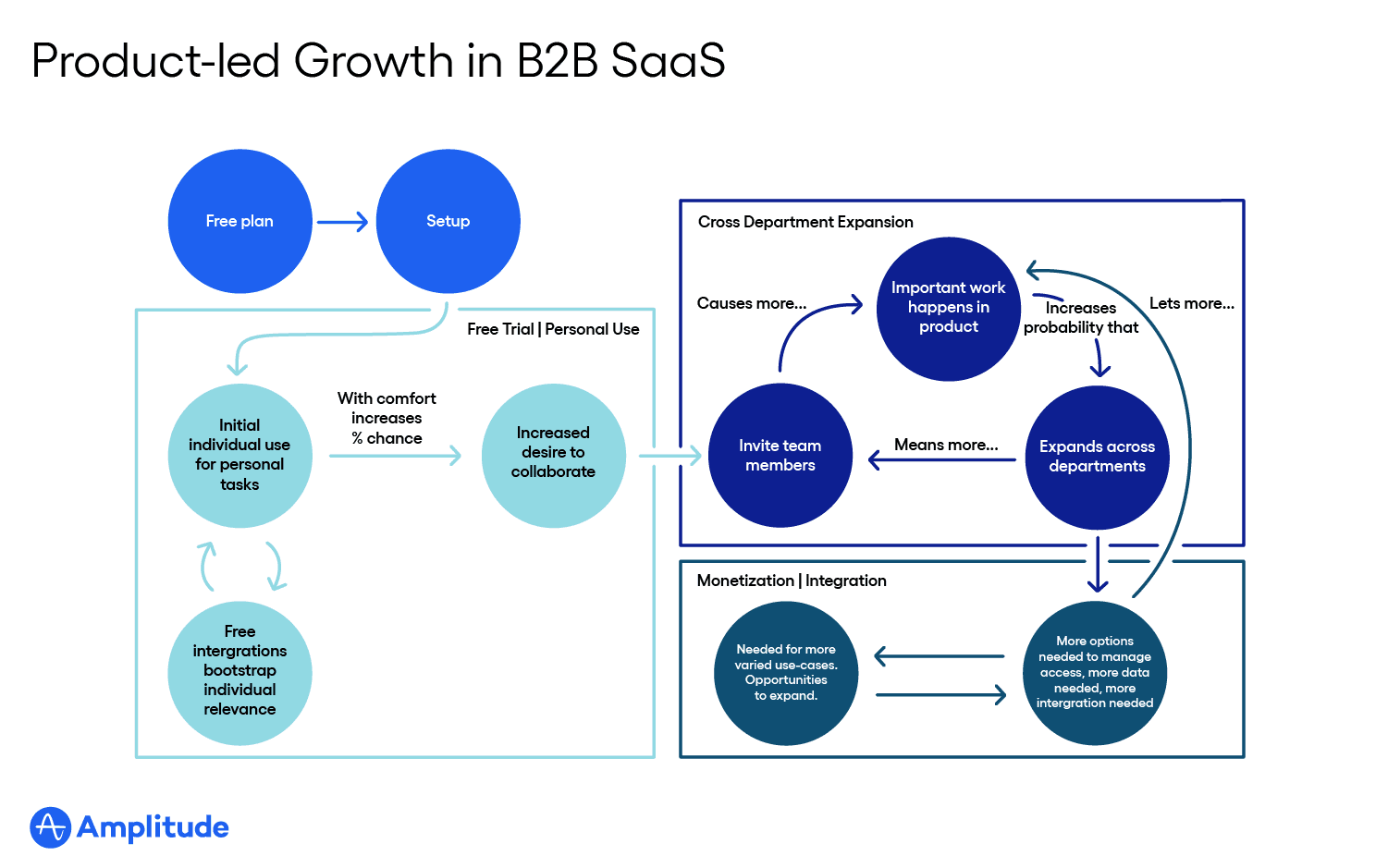7 Product-Led Growth Companies Paving the Way in Tech Today
Learn more about what PLG can do for your business with these stories of 7 companies that leveraged the product as a key driver of acquisition, engagement, and long-term retention.
If you have a great product, it needs to be part of your go-to-market strategy. Hundreds of companies today are thriving with product-led growth, a motion that positions the product as a primary driver of engagement, retention, and loyalty. Below you’ll find examples of product-led companies and the strategies they use to drive reliable growth.
Key takeaways
- Successful product-led growth companies sell products that are inherently viral, produce a network effect, and typically remove barriers to exploring the product through free trials or a freemium pricing plan.
- Effective product-led growth strategies convey a product’s value in the quickest way possible through a frictionless design and onboarding process.
- Common traits of the top product-led growth companies include higher rates of customer retention, lower CAC, exceptional UX, and an emphasis on innovation.
What is product-led growth (PLG)?
According to OpenView, the organization that first defined the concept, “Product-led growth (PLG) is a growth model where product usage drives customer acquisition, retention, and expansion.”
This method is different from sales-led and marketing-led growth strategies, which devote time, energy, and money into convincing customers that their product has high value. Rather than relying on traditional methods of growth, product-led companies enable the customer to experience the value by using the product.
PLG generates loyalty and retention nearly automatically through the digital user experience. However, your marketing and sales teams are still relevant to your business growth as they generate awareness and demand. Once those qualified leads are captured, your excellent product should take it from there.
Successful PLG companies have these things in common
In order to follow a product-led strategy, PLG companies should focus on alignment across teams and departments. With lower customer acquisition costs (CAC) and less spending on sales, advertising, and onboarding, a PLG strategy enables businesses to save money and time.
Traits of effective products in a PLG motion include:
- Seamless product design and functionality: PLG companies produce intuitive and user-friendly products. When the product is easy to use, engagement improves.
- Experiences that convey clear and immediate value: During product development, teams optimize the “time-to-value,” the time it takes for a customer to experience the value of your product after they sign up. The faster the user experiences and recognizes the benefits of the product, the more likely they are to convert.
- Personalization capabilities: 71% of customers expect personalization in digital products, which improves the user experience and drives growth. While not required, personalization is another factor that can bring engagement and retention to the next level in PLG.
- Frictionless exploration: PLG motions should remove barriers to trying the product. This means a prospect shouldn’t have to engage with sales reps to set up a free trial or freemium account. While sales involvement may be needed for larger enterprise deals, anyone who wants to buy a small number of licenses or simply test the product should be able to do so without having to talk to sales.
- Virality: A strong PLG company encourages shares, invites, and virality. The more users a product serves, the faster it will grow. Some products bake this organic “share factor” in with collaboration settings. For instance, a product may prompt a user to share their dashboard with people who don’t have access to the tool. The product can create a custom link for external viewers, who are also prompted to sign up for the tool when they explore the custom link.
- Network effect: The network effect is the phenomenon in which a product has a compounding value. The more people join it, the more useful the product is to everyone. PLG companies that have a product with a network effect grow rapidly when implemented by other teams at their company.

The network effect compounds the value of the product when it is used across departments. This is particularly useful in B2B SaaS. Learn more with Amplitude’s “5 Diagrams That Explain Product-led Growth.”
7 examples of companies doing product-led growth right, right now
Although there are many companies that have embraced product-led strategies, the following seven companies are some of the top performers in the PLG landscape. Each of them has steered away from dependence on sales-led strategies, leading to massive product and business growth that emphasizes an exceptional customer experience.
Miro
Miro has seen continuous growth since its inception in 2011, thanks in large part to its PLG strategy. Unlike other freemium models, Miro’s free subscription includes unlimited users—an important perk that drives sign-ups. Also, teams can take advantage of Miro’s 1,000+ simple and user-friendly templates. Templates encourage users to get started right away with Miro’s product, providing immediate value and utility to the user.
Moreover, Miro personalizes the template experience by presenting the user with seven onboarding questions. This type of customization is key to a customer-centric approach. Not only do the templates speed up the product learning process, but they also cater to the specific needs of the user. Miro also provides its community with a forum, meetups, and the “Miroverse” to further strengthen its PLG efforts.
Notion
Like Miro, Notion also provides its users with templates that make it very easy to get started on its platform. In addition, Notion produces tutorials and webinars to educate users and team leaders on Notion tools, as well as other productivity and collaboration workflow content. In each of these videos, Notion demonstrates how its product is a versatile tool that provides an “all-in-one workspace.”
Notion also nails product-led growth by tracking effective KPIs. Since Notion also offers a freemium model, simply tracking the number of sign-ups would not provide actionable data the company can use to improve its product or business strategy. Instead, Notion’s KPIs include data on the number of engaged users who have a high potential of becoming paid users, teams that upgrade to a paid Notion account, and teams that are likely to upgrade to an enterprise account.
Dropbox
From a PLG perspective, Dropbox has built-in virality. You can quickly share folders and links with others even if they don’t have a Dropbox account. When people open a Dropbox link, they automatically become users without actually having to sign up (though many often do once they see the value).
Dropbox also offers a referral program by which users can gain extra storage space. Referral programs encourage new users to sign up and try a product, enacting the product-led growth cycle all over again.
Slack
Slack is one of the quintessential examples of a product-led growth company. Through the network effect, Slack was able to grow its business as more and more professionals around the globe saw the value of joining the platform with their co-workers.
Slack also understands the power of upselling. Upgrading to a paid Slack subscription allows users to store all of their messaging history. This is incredibly important for large companies that want receipts of all of their communications. It is no wonder Slack’s revenue increased from $12 million in 2014 to $902 million in 2021.
Atlassian
Atlassian’s greatest strength is its “internal champions,” or brand advocates/power users, who drive the network effect. According to Matt Ryal, a product team leader at Atlassian, “the positive feedback that a successful champion gets within their company makes them more likely to introduce the product again in future roles.”
Atlassian also prioritizes end-user feedback to improve its product. Its support center and systems dashboard enable users to report bugs and make suggestions and feature requests. Then the product team reviews the feedback and makes adjustments when possible. Atlassian also provides its users with a community forum in which users can ask questions and learn from one another.
HubSpot
HubSpot developed a customer success and sales team for freemium users to guide them through the user journey. This team also functions as a method for collecting feedback and data for the product team. However, soon after launching their PLG strategy, they found that unqualified leads were wasting their sales team’s time. Instead of acquiring as many leads as possible, they decided to prioritize quality over quantity through segmentation.
According to David Barron, global director of sales at HubSpot, “This taught us how critical it was to ruthlessly segment users/leads by creating a system that connected our best-fit prospects with our sales folks, and pushed all others towards full self-service.”
Zoom
Zoom took off during the pandemic due not just to the sudden need for reliable teleconferencing but also to the low barrier to entry. Unlike its competitors, like Microsoft Teams and Skype, Zoom does not require its users to have an email address.
As a freemium product, Zoom is also financially accessible to all organizations and individuals who made the switch to virtual meetings. Zoom is also inherently viral and has become synonymous with video chatting. Its loyal user base and popularity led to people using the term “Zoom” as a verb: “Do you want to Zoom?”
Get started with product-led growth
If you want to implement a product-led growth strategy in your company, your first step should be to ensure that your product is designed to serve the end user. As Calendly founder and CEO Tope Awotona puts it: “Designing for end users is really understanding what they do—and it’s also truly understanding who you serve.”
Once you feel confident that your product will fill a need in the market, formulate your PLG strategy. One way of doing this is to follow OpenView’s five-stage framework with these phases: activation, start, discovery, convert, and scale. Be sure to read the full post on ProductLed.
To continue your learning on product-led growth, you can also download Amplitude’s free PLG worksheet or watch the “Driving Product-led Growth” webinar featuring Elena Verna and Forrester.
References
- Matt Ryall: Tech & opinion since 2002, Product-led growth lessons from Atlassian
- OpenView Partners, 2022 Product Benchmarks
- OpenView Partners, Product-led growth: Fueling the fastest growing software companies
- ProductLed, Product-led Growth Companies: A Framework for Prioritization

Mallory Busch
Former Senior Content Marketing Manager, Amplitude
Mallory Busch formerly ran the Amplitude blog, frequently named a best blog for product managers. She also created AmpliTour, the live workshop for beginners to product analytics and 6 Clicks, the Amplitude video series. She produced the Flywheels Playbook, wrote The Product Report 2021 and produced The Product Report 2022. A former developer and journalist, Mallory's written work and coding projects have been published by TIME, Chicago Tribune, and The Texas Tribune. She graduated from Northwestern University.
More from Mallory





